This post may contain affiliate sales links. Please read my disclosure policy.
Let’s talk about how to make a water bath for a cheesecake! They aren’t hard to set up and the extra step will give you a beautiful, creamy cheesecake free of cracks! Plus, I’ll share with you my tricks for no leaks!
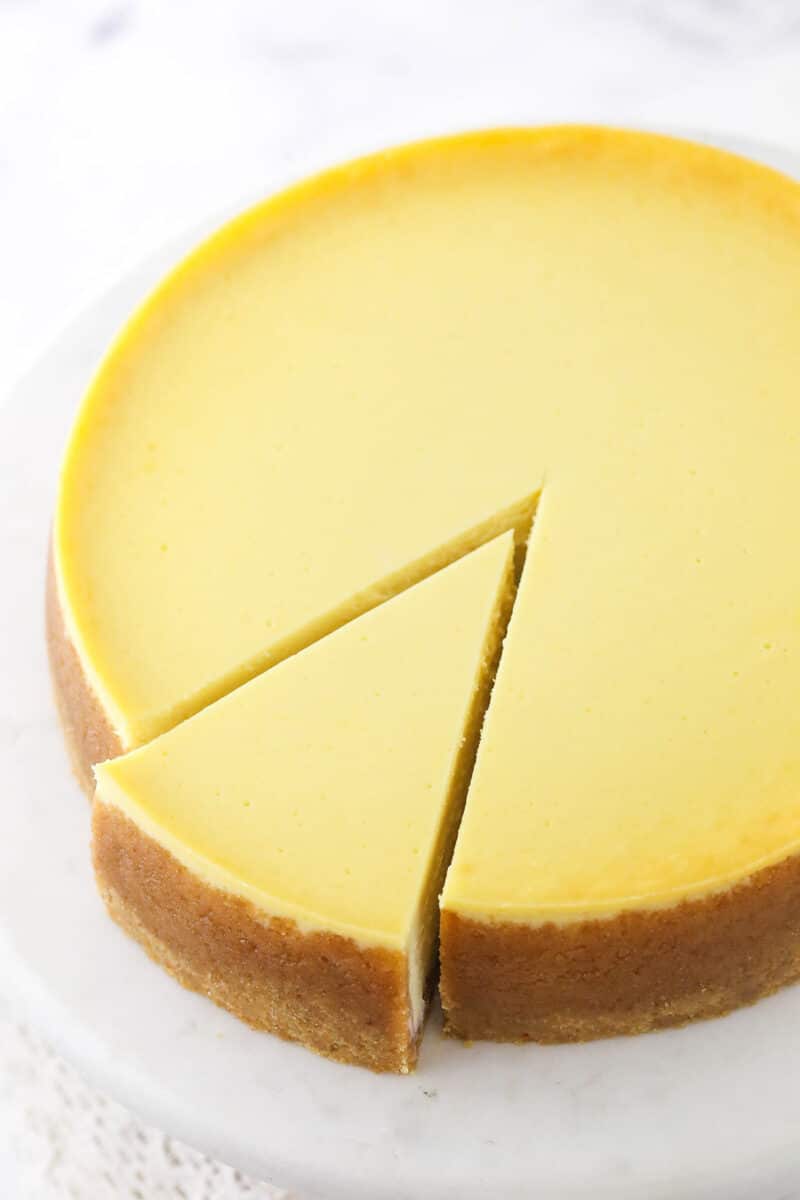
There’s no doubt that I’m a huge fan of cheesecake. The sheer number of cheesecake recipes on my site gives me away. I love the classics and I love unique twists. And with all the cheesecake baking I’ve done over the years, I’ve learned a lot and my number one tip for success is a water bath. If you want a beautiful cheesecake free of cracks, over-browned edges and a sunken middle, you need to use a water bath.
What is a Water Bath?
Cheesecake is basically a custard-based dessert and therefore needs to be treated differently. A water bath, also known as a bain marie, is our secret to the perfect cheesecake. It produces steam that wafts throughout the oven, helping to ensure that the cheesecake cooks evenly and stays nice and creamy. It also moderates the heat on the sides of the pan so that they edges don’t cook much faster than the center.
Why Use a Water Bath?
The benefits of a water bath are plenty. It gives you a cheesecake that:
- Is free of cracks.
- Doesn’t over cook or over brown on the edges.
- Doesn’t sink in the middle while cooking.
- Stays super smooth and creamy.
However, water baths can often be confusing, leak and generally be a pain. So I’m excited to share my methods with you today because they aren’t complicated, won’t leak and it is SO much better than not using a water bath. You spend so much time making a cheesecake – don’t skip this final step and end up with an underwhelming result.
What You’ll Need
I’m going to share a few ways of setting up a water bath. You have options! The first requires the least amount of equipment, but is most likely to leak. The other two will keep you leak-free and really depend on preference. Here’s what equipment you’ll need.
- Springform Pan: You’ll need a 9 inch springform pan for most recipes.
- Large Pan: “Large” is a little vague, but ultimately you need a pan larger than the springform pan that the water will actually go in. It can be a large roasting pan or a large cake pan (I use a 12 inch cake pan).
- Aluminum Foil: This is optional depending on the method you choose. I recommend to long, heavy duty foil.
- Slow Cooker Bags: These are optional depending on the method you choose, but can help prevent your water bath from leaking.
- Large Silicone Pan: This is also optional depending on the method you choose, but it is the easiest method and most likely to prevent leaking. You have to buy the pan, but if you bake a lot of cheesecakes, it will totally be worth it.
- Hot Water: To fill your larger pan.
How to Set Up A Water Bath
Setting up the water bath is a few step process. The wrapping of the pan happens after you bake the crust and adding the hot water happens just before you bake it.
- Make your crust: The first thing you need to do for any cheesecake is properly prep your pan and add your crust. I typically use a graham cracker crust or Oreo crust. I typically pre-bake my crust a bit.
- Prep your pan for the water bath: After you bake your crust, you can go ahead and prep your pan for a water bath using one of the 3 methods below. After prepping the springform pan, place your springform pan into the larger roasting pan or cake pan.
- Add cheesecake filling: Now you can make your cheesecake filling and add it to the crust.
- Add hot water: Bring your pan close to the oven so prevent moving a pan full of water all over the place, then add the hot water to the outer large pan.
- Bake cheesecake: Place your cheesecake and it’s water bath in the oven and bake as directed.
- Cool Cheesecake: When your cheesecake has baked, you can remove it from the water bath, but leave it in the springform pan. You can set the cheesecake on a cooling rack to cool to room temperature and then refrigerate it, or just place it straight in the fridge to cool completely. If you don’t want any condensation forming on top, let it cool to room temperature before refrigerating it.
Three Water Bath Methods
Method 1: Aluminum Foil
For this method, you’ll use aluminum foil around the outside of your springform pan. I’d recommend two or three layers to try to prevent leaking. You also don’t want to crinkle the foil too much at the bottom. It can cause little cracks to form in the foil, which can cause leaking. Leave it a touch looser around the bottom.
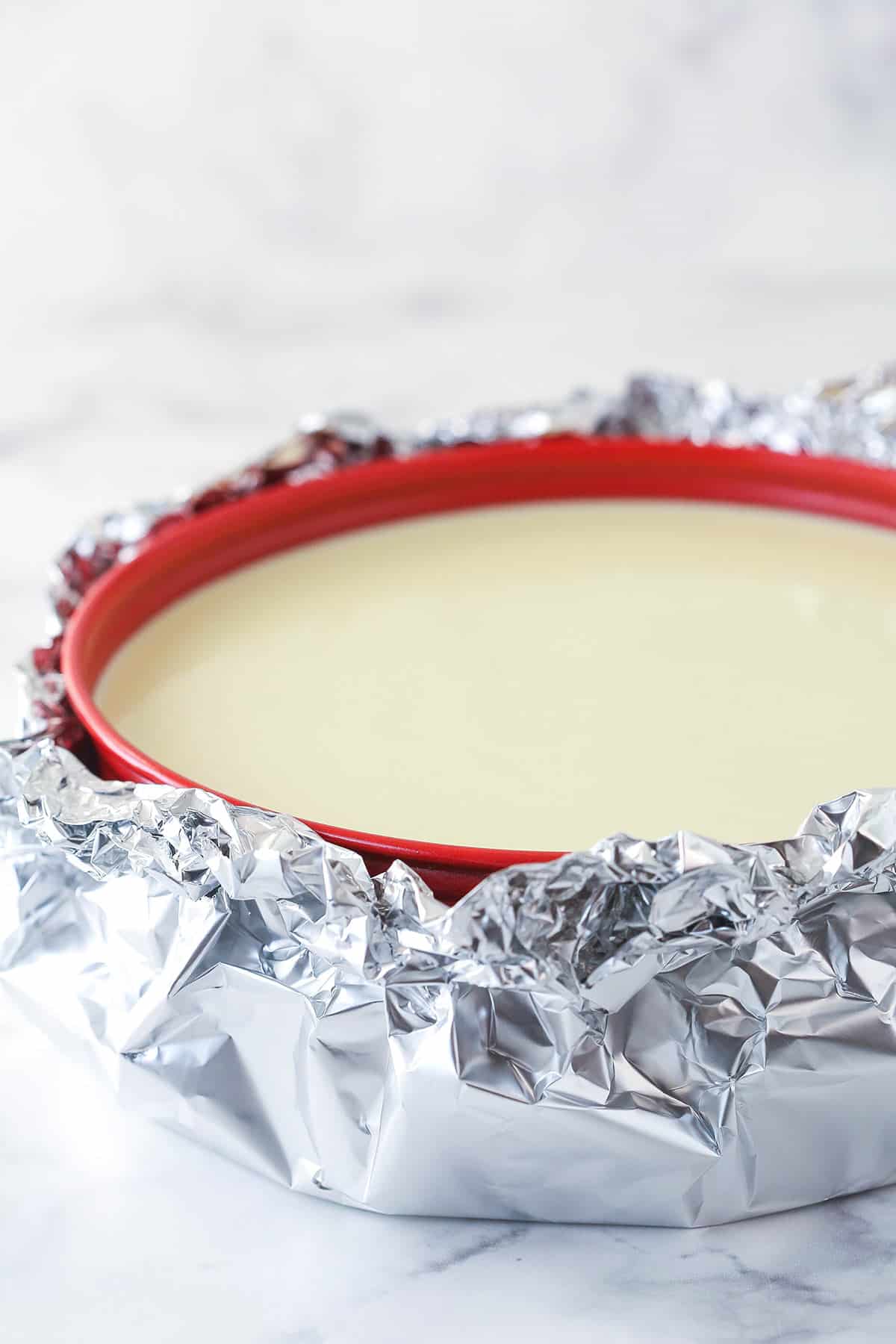
Set your foil-wrapped pan in your larger pan and fill the larger pan with hot water that comes about half way up the side of the springform pan. The water can boil a touch during baking, so you don’t want it to come up too high or the water could “jump” over the foil. Finally, bake your cheesecake according to your recipe.
Method 2: Slow Cooker Bags
I have been using this method for a long time. It was my original method for a leak-proof water bath and I’ve been doing this for years. Slow cooker bags can hold up to the heat and won’t form little holes or cracks, like aluminum foil. For this method, first wrap your springform pan in the slow cooker bag. The bag will be a little big, so tie a knot with the excess.
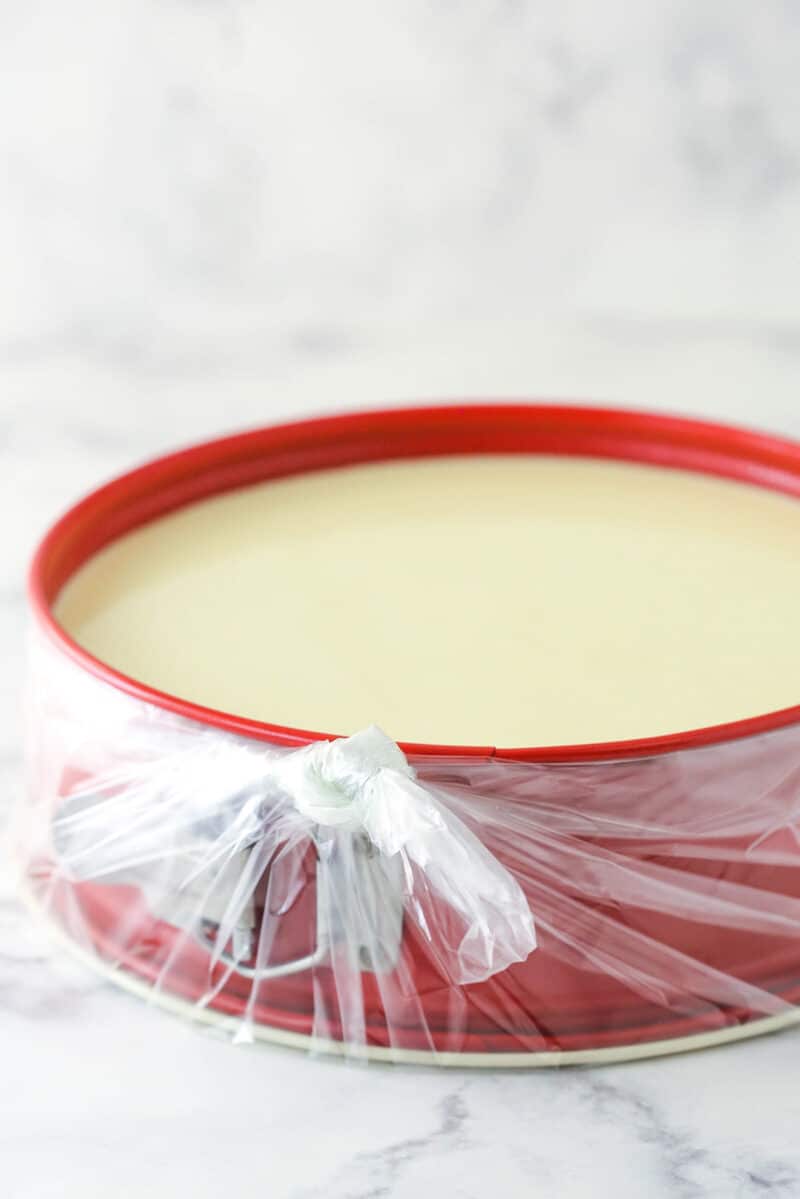
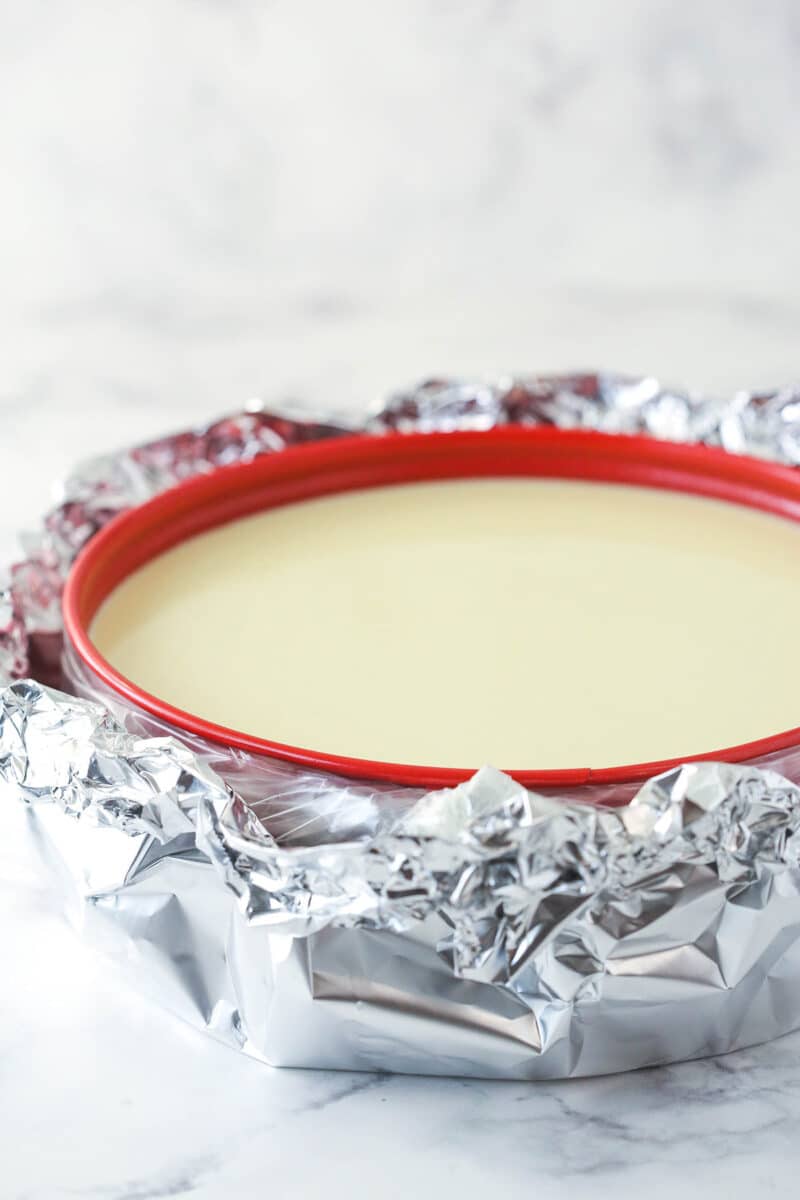
Wrap a layer of foil around the outside of the slow cooker bag, then place the pan in the larger pan. Fill the larger pan with hot water that comes about half way up the side of the springform pan, then bake your cheesecake.
Method 3: Silicone Pan
This is my most recent method. After getting a lot of questions about using a silicone pan in place of the slow cooker bag and foil, I decided to try it. I totally fell in love with this method! No need for wrapping and unwrapping, and no need to worry about leaking. Another plus is that the silicone pan is reusable so you won’t have to buy foil and bags over and over.
So for this method, just set your springform pan in the silicone pan. Place that into the larger pan that will hold the water, then add your hot water and bake. Just keep in mind that the water should only be about halfway up the sides of the silicone pan. You don’t want it to come up too high. The water could boil a touch while baking and you don’t want it to “jump” over the sides of the silicone pan and get into your crust.
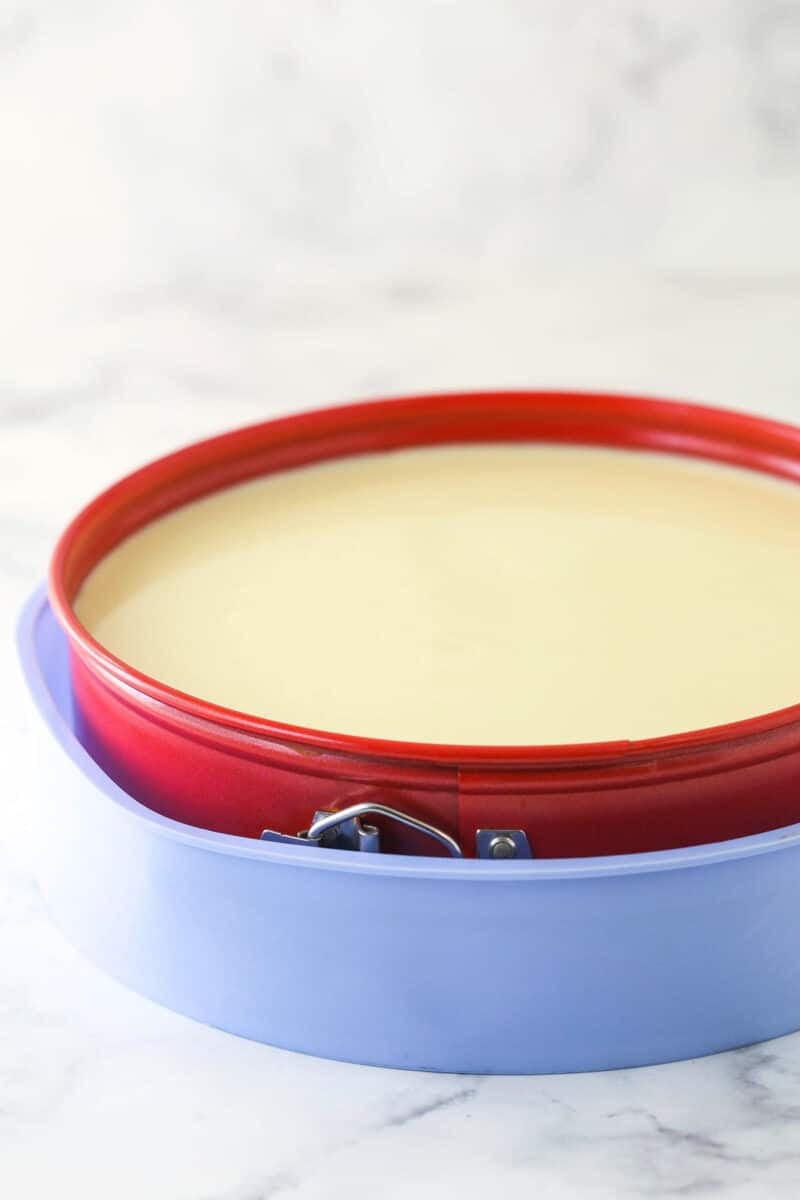
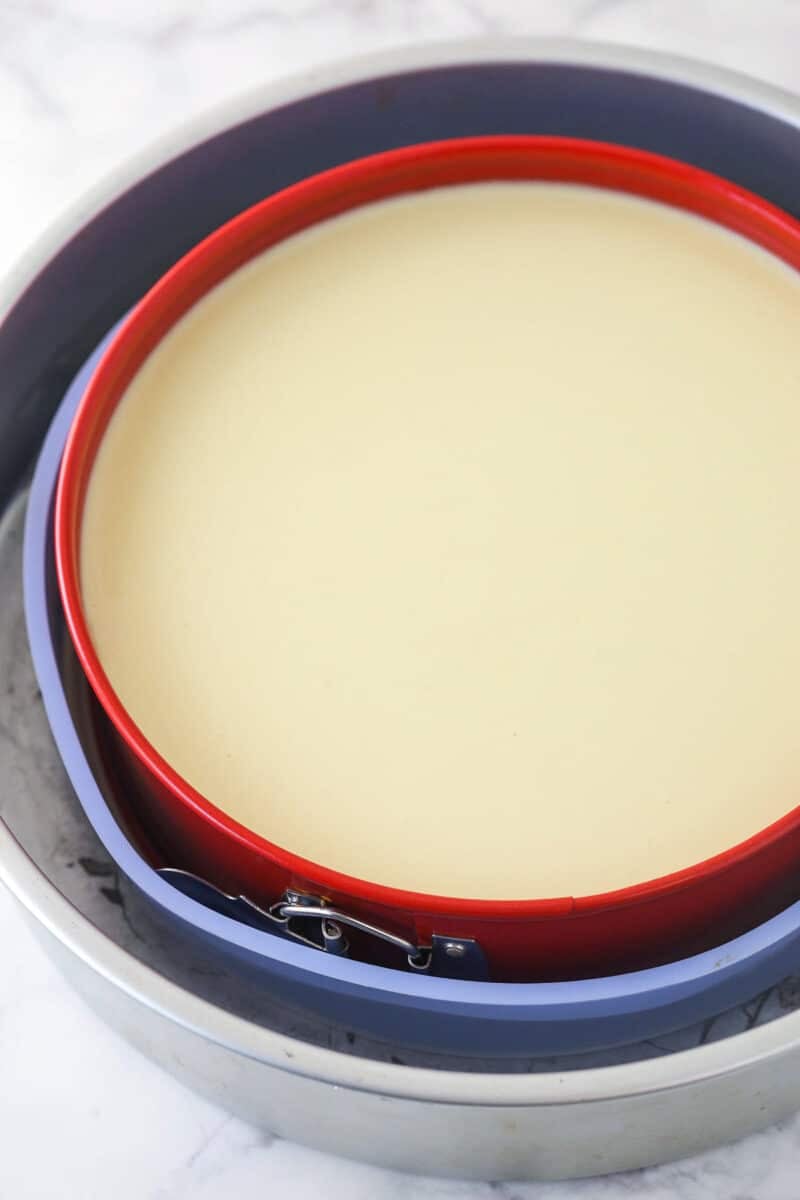
Compare: Cheesecake Baked With and Without a Water Bath
I’ve told you what happens when you bake a cheesecake without a water bath, and showed you how to set one up. Now let’s look at the final result with and without a water bath. Results could vary a bit between recipes (I used my Classic Vanilla Cheesecake), but this is generally what the difference looks like.
Cheesecake Baked with Water Bath
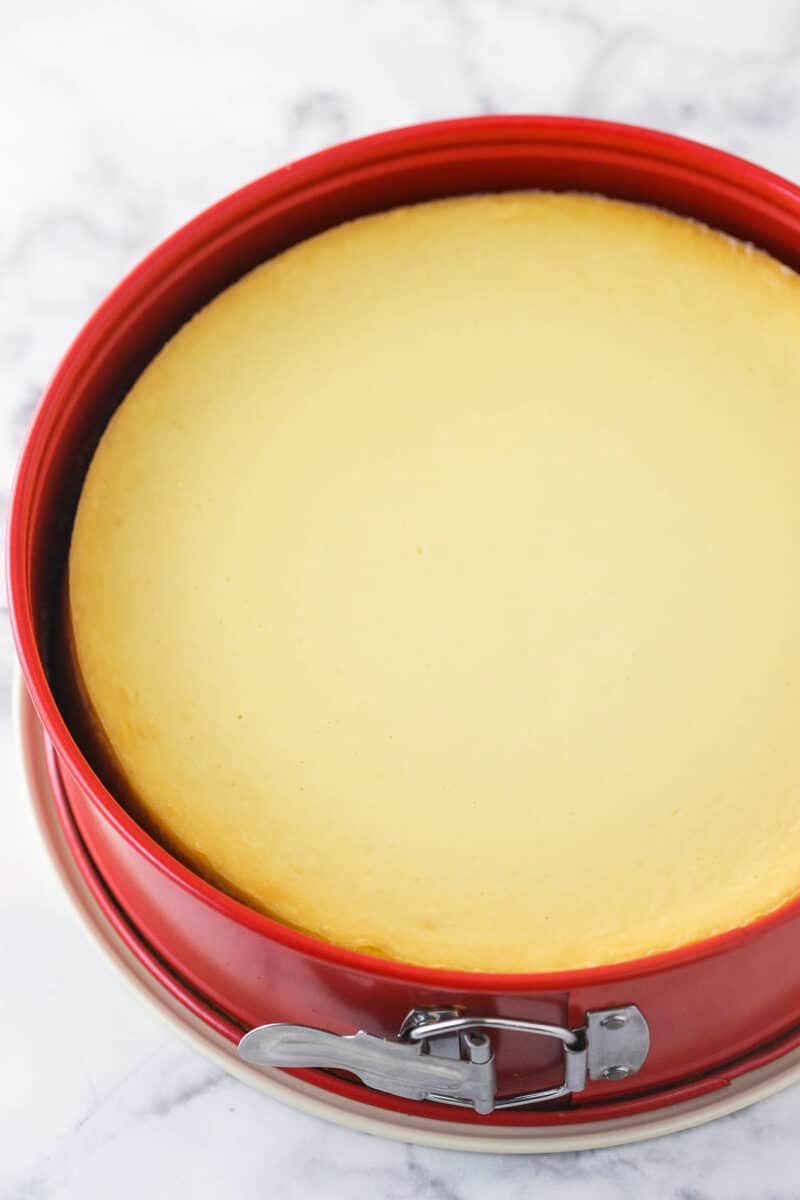
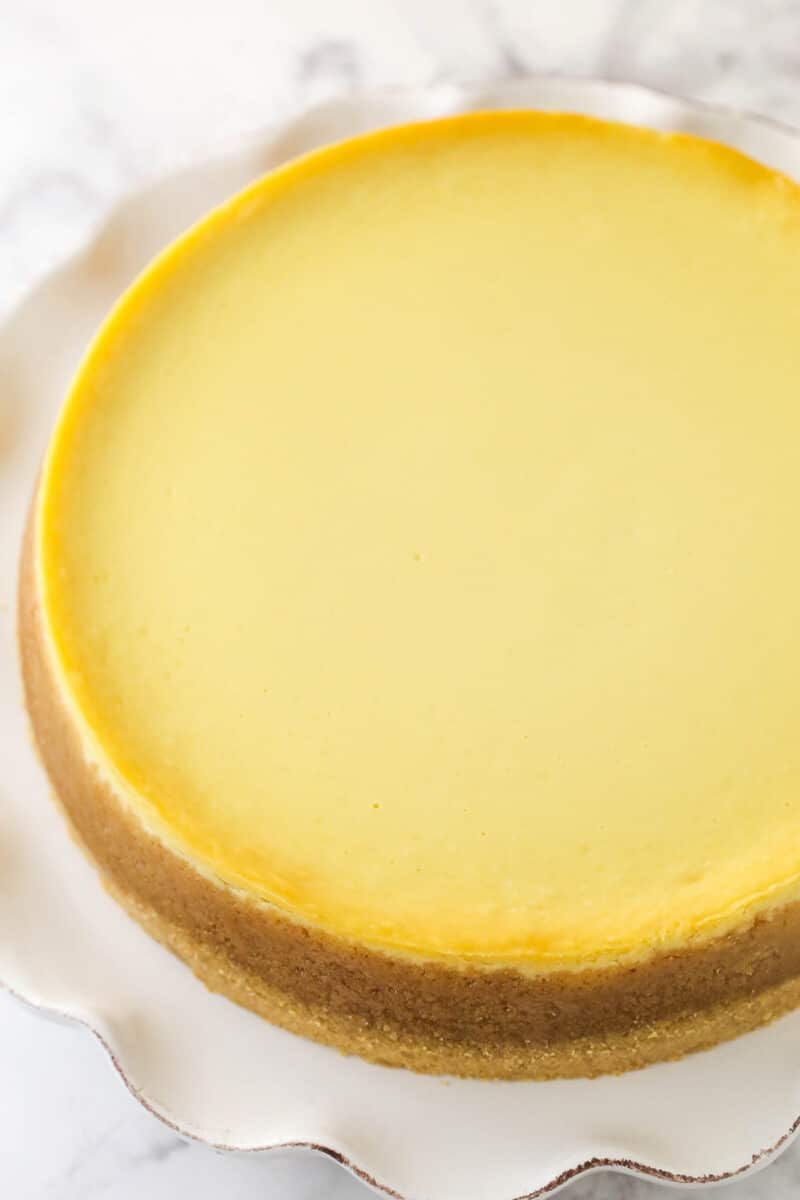
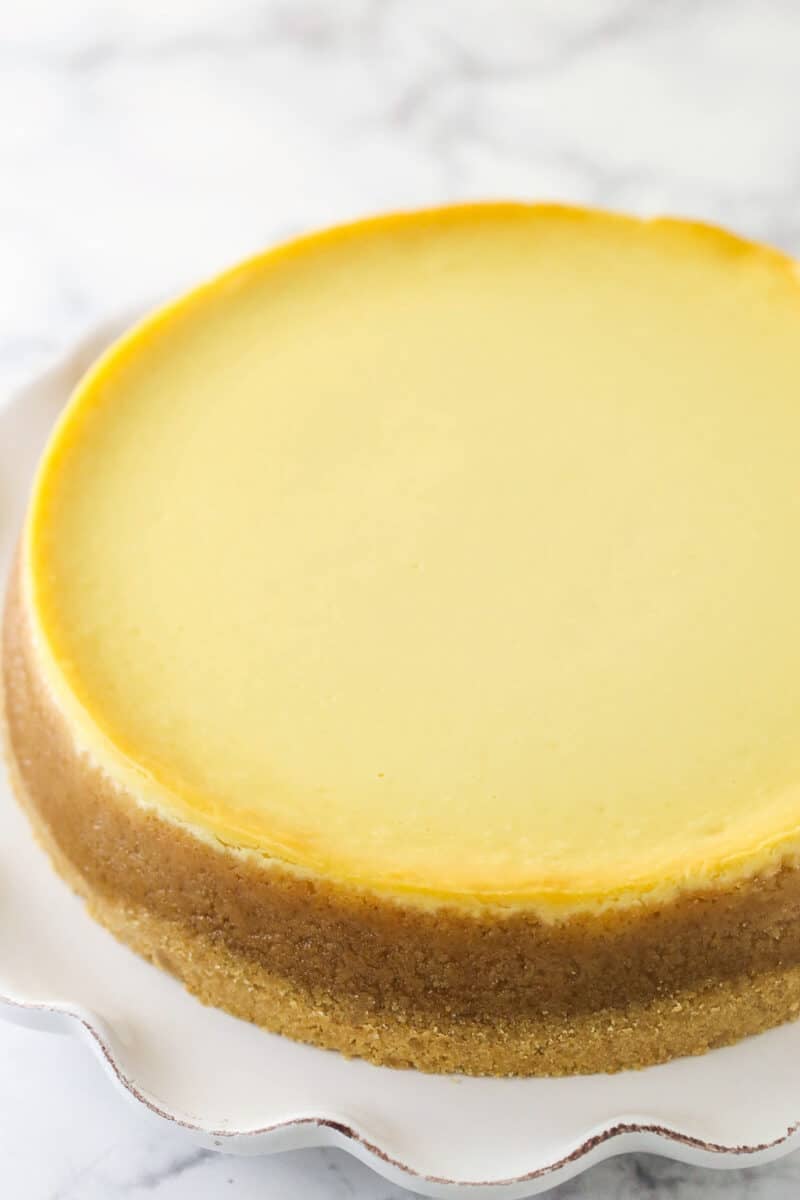
Cheesecake Baked Without Water Bath
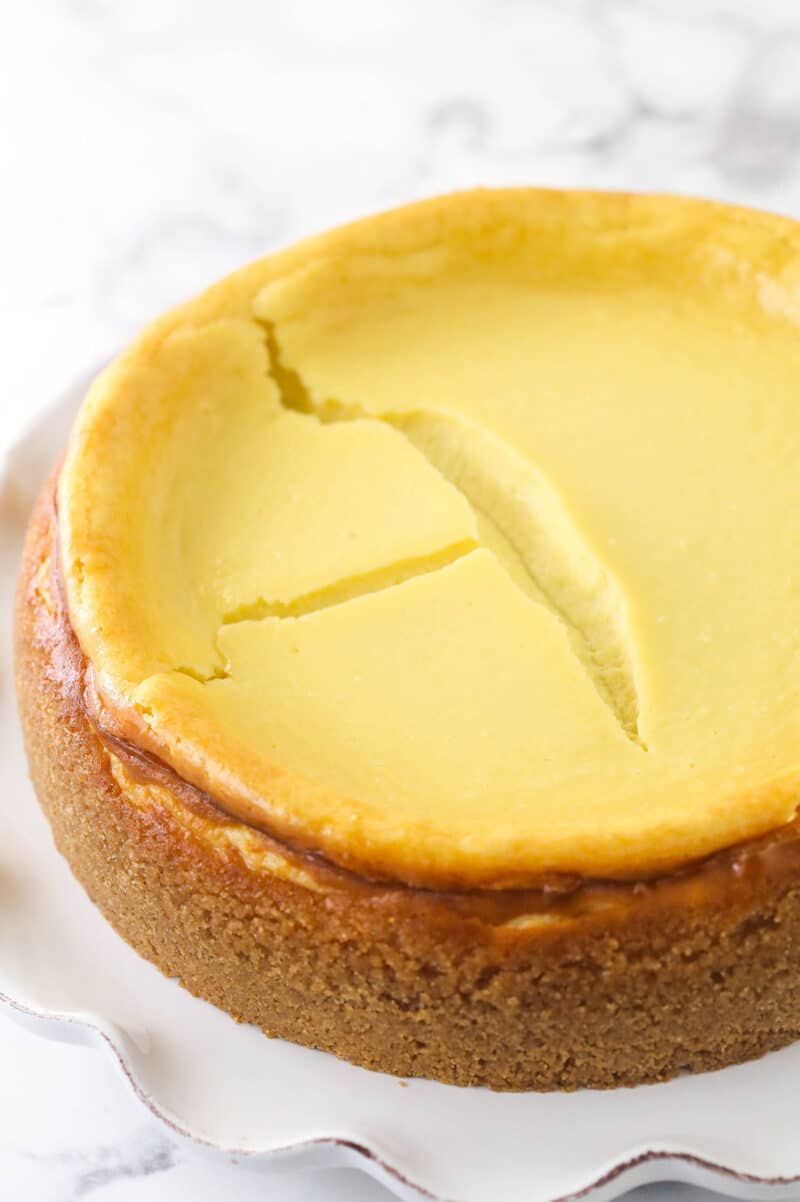
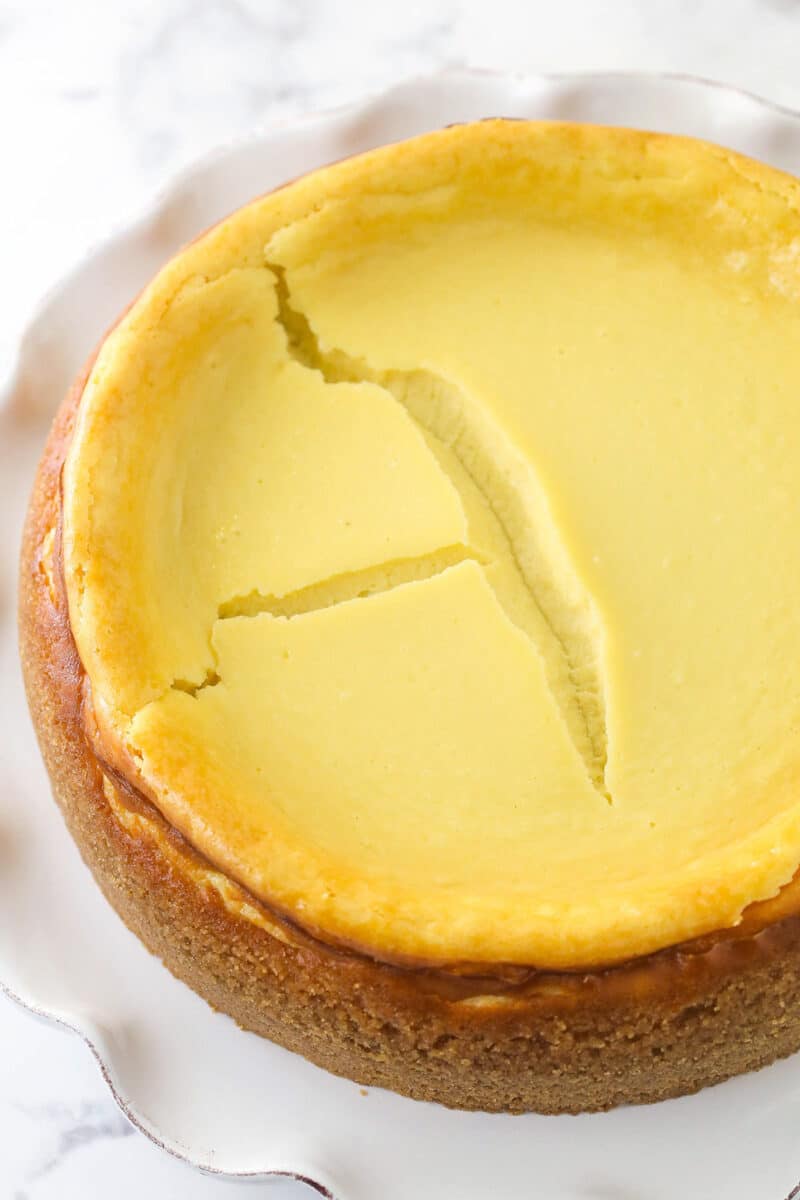
Can I Just Put A Pan Of Water On The Rack Below?
I get this question quite a lot, so I tested it. While your results may vary depending on the recipe, I found that the result was kind of in the middle. It still browned a little more than when you use a water bath and still fell a bit, which you can see in the sides, but otherwise it did well. It didn’t fall in the center and it didn’t crack. So if you’re really averse to using a water bath and don’t mind the slight imperfections, this would certainly be an option.
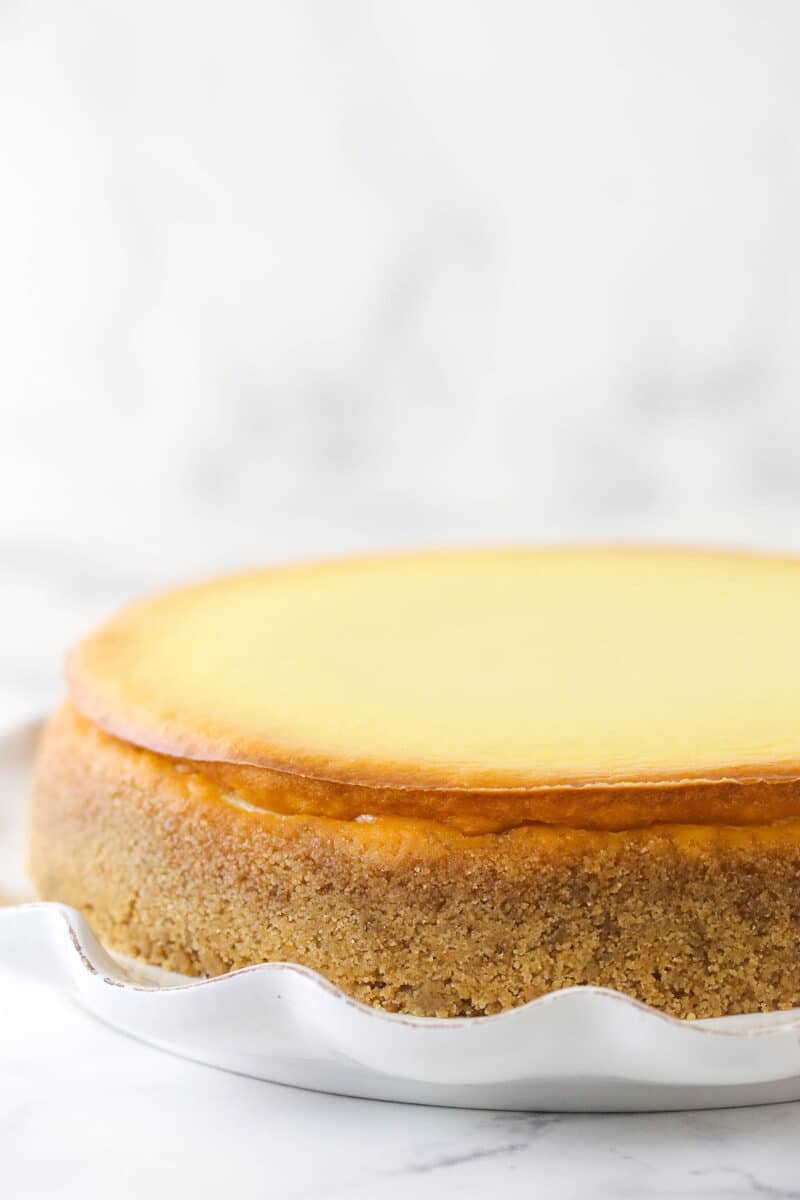
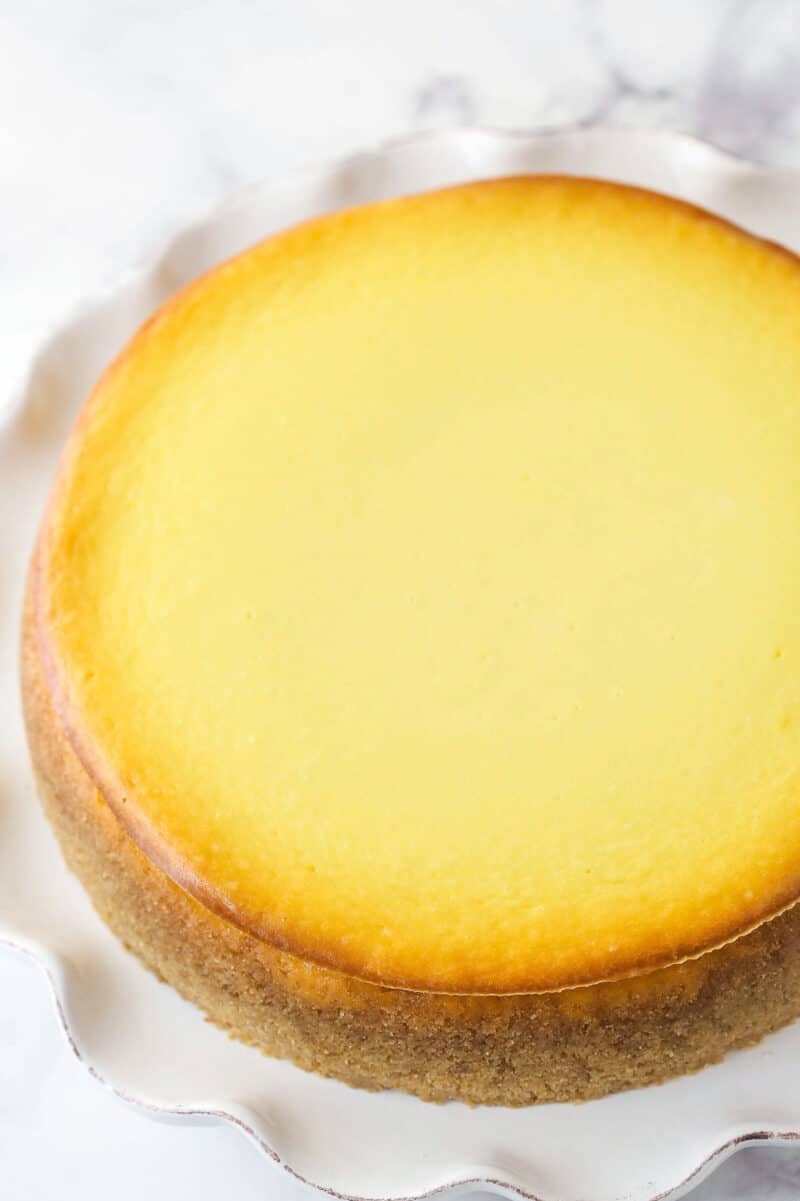
When do I NOT Need a Water Bath?
If you’re using a recipe that doesn’t call for one, then that should be fine. Mini cheesecakes also don’t require a water bath, nor do 9×13 cheesecakes. Their smaller and thinner size means they bake more evenly without having to use a water bath. And of course a no-bake cheesecake doesn’t need one either.
Pro Tips For a Great Cheesecake
- Don’t over or under bake your cheesecake. Check out my post on how to tell when your cheesecake is done baking.
- Add the water to your water bath pan with the pan near the oven. Trying to carry a heavy pan full of water and a cheesecake without it splashing around is not easy.
- Cool it slowly. All of my cheesecake recipes call for a two step cooling method that allows the cheesecake to bake fully while not over baking. It also helps to avoid cracking.
- Let your cheesecake chill and firm up before removing it from the springform pan. When you’re ready, check out my tutorial and video for how to remove a cheesecake from the springform pan.
- When you’re ready to store your cheesecake, check out my post on storing it, freezing it, etc.
- If you want to bake a cheesecake in a size other than a 9 inch pan, check out my guide to adjusting cheesecake sizes.
Now that you know how to do a cheesecake water bath, here are some amazing cheesecake recipes to try:
- Strawberry Cheesecake
- Best Oreo Cheesecake
- New York Style Cheesecake
- Dark Chocolate Cheesecake
- Turtle Cheesecake
- Cinnamon Roll Cheesecake
- Amaretto Cheesecake
- S’mores Cheesecake
- Mint Oreo Cheesecake
- Apple Cinnamon Cheesecake
- German Chocolate Cheesecake
- Red Velvet Cheesecake
- Caramel Apple Cheesecake
- Pumpkin Cheesecake
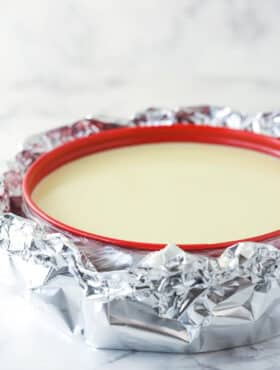
How to Bake Cheesecake in a Water Bath
- Prep Time: 45 minutes
- Cooling Time: 4 hours
- Cook Time: 2 hours 15 minutes
- Total Time: 7 hours
- Yield: 12-14 slices
- Category: Dessert
- Method: Oven
- Cuisine: American
Description
Let’s talk about how to make a water bath for a cheesecake! They aren’t hard to set up and the extra step will give you a beautiful, creamy cheesecake free of cracks! Plus, I’ll share with you my tricks for no leaks!
Ingredients
- Springform pan
- Aluminum foil, optional depending on method
- Slow cooker bags, optional depending on method
- Large silicone pan, optional depending on method
- Large pan (Like a roasting pan or a 12 inch cake pan)
Instructions
- Make your crust: The first thing you need to do for any cheesecake is properly prep your pan and add your crust. I typically use a graham cracker crust or Oreo crust. I typically pre-bake my crust a bit.
- Prep your pan for the water bath: After you bake your crust, you can go ahead and prep your pan for a water bath using one of the 3 methods discussed above. You can either: 1. Wrap your pan in two or three layers of aluminum foil, 2. Wrap you pan in a slow cooker bag and one layer of foil, or 3. Place your springform pan in a slightly larger silicone pan. Place your springform pan into the larger roasting pan or cake pan.
- Add cheesecake filling: Now you can make your cheesecake filling and add it to the crust.
- Add hot water: Bring your pan close to the oven so prevent moving a pan full of water all over the place, then add the hot water to the outer large pan.
- Bake cheesecake: Place your cheesecake and it’s water bath in the oven and bake as directed.
- Cool Cheesecake: When your cheesecake has baked, you can remove it from the water bath, but leave it in the springform pan. You can set the cheesecake on a cooling rack to cool to room temperature and then refrigerate it, or just place it straight in the fridge to cool completely. If you don’t want any condensation forming on top, let it cool to room temperature before refrigerating it.


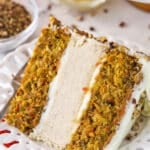
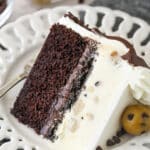

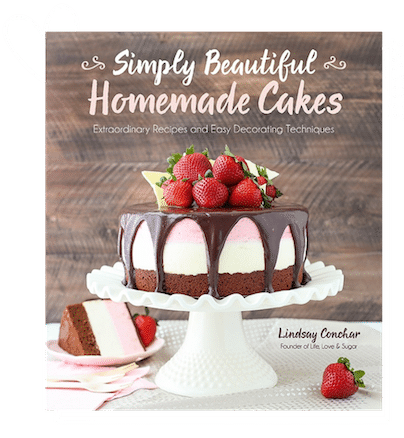
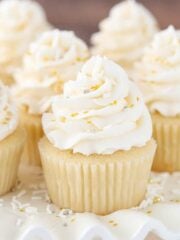
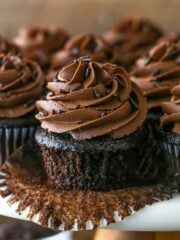
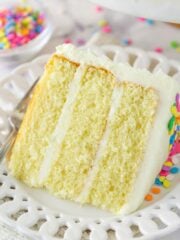


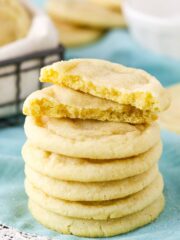
I have never been able to keep my cheesecake from getting wet. I purchased a moat but my cake would often crack. A few months I purchased cake pan wraps. I experimented with the wraps in combination with my moat pan. It works amazingly!
I haven’t heard of those, but I’m glad they’ve worked well for you!
I had the same issue as another poster with moisture getting into/through the aluminum foil/slow cooker bag. I was wondering if it has anything to do with the moist environment inside the oven causing condensation to seep from the top in between the pan and the protective layers (if that makes any sense). Water should not be penetrating a double layer of foil and the plastic bag.
This post was just updated yesterday. Did you read through the new text? I explain a little bit about how water can get in despite the foil and oven the bag. With aluminum foil, it can actually get tiny little cracks in it if it’s crinkled up too much, which could let water in. And with the oven bag, you want to make sure it comes up most of the way on the sides of the pan and then you don’t want to fill the water level too high because it can actually boil a touch during baking and then it can kind of jump over the side of the foil and even the oven bag. I hope that helps!
Mine leaked through the slow cooker liner as well unfortunately. Does this ruin the cake?
No, it should be fine. The crust may be a little more moist than normal, but it will be fine otherwise. Maybe next time make sure that the water liner comes up all the way up the sides of the pan and that the water in the pan doesn’t come up too high. If the water boils a little bit during baking, can kind of jump up over the sides of the bag if the water line is too high.
Love them idea of using the silicone pan to prevent leaks. Do you adjust (increase) baking time using this method since the silicone is more dense than the foil/liner method? Thanks so much…love your website!!
No, you don’t need to adjust the baking time at all. I hope you give the silicone pan a try!
I love the idea of using the silicone pan, but it also got me thinking. why not just use another cake pan? I don’t have a silicone pan, but like you I own lots of larger cake pans. Do you think that it would work? If not can you please explain why not to me? Thank you in advance.
You could certainly try it. I wouldn’t know for sure without trying it.
Hi Angelina! I in fact have used a larger cake pan around my springform pan it fits snuggly and then use an even larger cake pan for the water bath. Has been working for me with no cracks for years now. Tin foil was just not reliable for me, many a soggy crust which typically firms up in the fridge but still.
Hello Lindsay!
I’m trying this today, making for an event this weekend. I do plan on transferring to cake stand, any tips on how to accomplish this? It scares me!
Also would shortening be okay to grease the sides with?
Thanks!!
I have a brand new post from this week on how to remove your cheesecake from the springform pan to a serving platter or cake stand. There’s a whole video where I walk you through it. I hope it’s helpful!
And yes, shortening should be fine.
Is it necessary to place the cheesecake pan into the water bath? If it’s just to create a moist environment for the cheesecake to bake in why can’t a pan filled with water be placed on the rack below the cheesecake? Wouldn’t that serve the same purpose? It appears that water doesn’t necessarily have to touch the pan as demonstrated when you place your cheesecake into a larger silicone pan then into the water bath.
I actually have an update to this blog post coming, which goes into this. I actually baked my vanilla cheesecake with a water bath, without a water bath and with a pan of water beneath the cheesecake, as you describe, and took photos of the results to share. While the pan beneath the cheesecake was better than using no water at all and it didn’t end up with cracks, it did still brown more and kind of fall a bit while cooling, leaving with you a cheesecake that was fine, but not as good/attractive as a water bath. I also noticed while it baked, that it cooked much more quickly on the edges than in the middle when compared to a true water bath. The water bath does create a steamy and moist environment, but having it touch the sides of the pan also insulates it. Have you ever used bake-even strips that are made or cake pans? You wet them and fasten them around the outside of the cake pan. It helps the edges of the cake not bake as quickly so that the middle has time to heat up and rise with the sides of the cake, giving you a flatter cake without a dome. Something similar happens with cheesecake in a water bath. It bakes more evenly, which ultimately leads to a better final result. Can you do it without a water bath? Sure. But for the BEST result, I always recommend a true water bath. Now recipes may vary and I can’t speak to other people’s recipes, but I would still recommend a true water bath. Cheesecakes aren’t hard, but they are time consuming. Why not do it properly and have it turn out perfect. 🙂 I hope that helps!
Love it thanks
This is a wonderful way to make the cheesecakes. Thank you so much for this tutorial. Love it
I’m so glad it’s helpful!
This worked AMAZING for me!! I never thought to use a slow cooker bag!! I have spent way too many days wrestling with my spring-form pan and Tinfoil but not anymore!! It really is a game changer!! Thank you💜💜
I’m so glad it was helpful!
Wondering if we can re-use these liner bags in the oven again for another cheesecake?
Yes, definitely!
You can also use the oven bags that you bake chickens and turkeys in. That’s what I use. Some of them are small enough and you don’t have as much waste.
do you have to do the water bath
That would depend a little on the recipe, but I always recommend it.
I made a decent amount of cheesecakes and I always have a leak when wrapping, no matter what I did. I did find silicone cheesecake bath liners on Amazon that you just put the cheesecake pan into and no more leaks! They come in at least 9 and 10” round sizes.
For a 9.5” springform pan would I use a 10” silicon pan or is that too big? The foil wrap is not working for me and it is so sad. One recipe has me put water under on another rack and one recipe has me put the cheesecake in a pan of water. Why can’t the water always be on a lower rack? Thank you.
You could certainly try putting the water on the lower rack. People say that works. I’ve just never personally done it that way. Depending on what the sides of your springform pan are like, 10 inches may actually be too small. It really depends on your pan.
Lindsay – are you using parchment paper to line the (inside) bottom of springform pan for cheesecake?
Yes, I use parchment paper.
Why don’t you actually give the recipe instead of a run around?
There’s no recipe on this post. It’s a tutorial.
Great ideas thanks for your input!
After you’ve baked your cheesecake what’s the best way to “hold” it for a couple days before serving?
Just make sure it’s well covered. Ideally, you’d have room to store it in an air tight container.